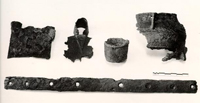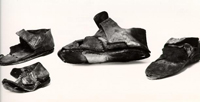Wetherburn's Tavern Archaeological Report, Block 9 Lot 20 & 21Originally entitled: "The Wetherburn Site Block 9,
Area N, Colonial Lots 20 & 21 Volume 2, Part I
The Artifacts from the Wells"
Colonial Williamsburg Foundation Library Research Report Series - 1179
Colonial Williamsburg Foundation Library
Williamsburg, Virginia
1990
THE WETHERBURN SITE
Block 9, Area N
Colonial Lots 20 and 21REPORT ON THE ARCHAEOLOGICAL EXCAVATIONS OF 1965-1966
Volume II, Part I
THE ARTIFACTS FROM THE WELLS
 Diagram of Well C - oversized image
Diagram of Well C - oversized image
| Table of Figures |
| Bibliographic Abbreviations |
| Introduction |
| Description of the Artifacts |
| Well B. Figures 1 - 3 |
| Well C. Figures 4 - 12 |
| Photograph Negative Numbers |
| Frontispiece. | Diagram of Well C. |
| Figure 1. | Well B, ceramics, glass, small finds. |
| 2. | Well B, iron items |
| 3. | Well B, Turlington's Balsam bottle |
| 4. | Well C, glass and ceramics. |
| 5. | Well C, ceramics and small finds. |
| 6. | Well C, Chinese porcelain bowls and green glazed plate. |
| 7. | Well C, Label decanter. |
| 8. | Well C, Beverage bottle and snuff bottle. |
| 9. | Well C, Shoes. |
| 10. | Well C, Well bucket and chain. |
| 11. | Well C, Adze and brush. |
| 12. | Well C, Fabrics and stuffing. |
Bibliographic Abbreviations
| Haynes | E. Barrington Haynes, Glass Through the Ages, Middlesex, 1959. |
| Rackham | Bernard Rackham, Early Staffordshire Pottery, London, 1951. |
| Thorpe | W. A. Thorpe, A History of English and Irish Glass, London, 1929 |
| Watkins & Noël Hume | C. Malcolm Watkins and Ivor Noël Hume, The "Poor Potter" of Yorktown, United States Museum Bulletin 249, Washington, D.C., 1967. |
Introduction
The archaeological value of the contents of a well is two fold. Firstly the presence of moisture and organic material assists the preservation of objects which otherwise would disappear. Secondly immediately after its abandonment as a water source, the shaft is invariably used as a trash repository for a short period before being filled with soil and perhaps with debris from the well superstructure. Thus, a tightly sealed group of artifacts is obtained which is of great use to the archaeologist in dating other deposits. In the case of the main colonial well at Wetherburn's Tavern the items it contained were also of use to the architectural department in reconstructing the well-head and its fittings (including the well bucket) and to the Department of Collections in furnishing the building.
Excavations on colonial lots 20 and 21 revealed the existence of two shafts. The first known hereafter as Well C was abandoned about 1765 and yielded the bulk of the artifacts illustrated in this report. The open well shaft on lot 21 will be referred to in this volume as Well A, the date of its construction is believed to coincide with the abandonment of Well C.
2The attempted construction of Well B, its abandonment and the digging of Well C can be attributed on the evidence of the artifacts to the years between 1750 and 1755. Well C was initially filled in between 1762 and 1765. The existing shaft (Well A) was probably constructed to succeed Well C in the third quarter of the eighteenth century. While all the relevant areas of lot 21 were excavated no trace was found of a water source dating from the first half of the century. As lots 20 and 21 were under the same ownership from at least 1716 to 1759 it could be that the well serving both lots in this period was on lot 20. In this case the logical date for the construction of the first well (Well B) would not be c1750-1755 but rather about August 1759 when the lots were separated.
Well A.
This shaft was open and covered by a decaying wooden lid when work began on the site. It had been in use by Mrs. Haughwout in the present century, and had almost certainly been cleaned out many times in the course of its life. Nevertheless, there was a good deal of trash in the bottom filling it up to a depth of 21'6" below modern grade. The interior diameter was very small, a mere 2'7", and the entire head foundation was only 4'6" square. It had been repaired on at least three occasions, the bricks of both lining 3 and head foundation being of regular shape. However, shell mortar was used in the lower courses of the square foundation, indicating that it may have been built as early as the last quarter of the eighteenth century. That it could be no earlier is indicated by dating evidence retrieved from the filling of Well C. The filling at the bottom of Well A was not excavated. The shaft has not been restored.
Well B.1
This well was actually located on the eastern section of Colonial Lot 20, though it is evident that at the time it was dug that property line was no longer honored. (See Volume I, Figure 1). The hole was sealed by an area of nineteenth-century brick and reused-stone paving which may have been associated with the tavern's most westerly outbuilding shown on the Frenchman's Map (and later used as a school house) but for which no traces of wall foundations survived. (Volume I, Figure 6)
An unlined hole measuring 4'9" in diameter had been sunk to a depth of 4'6" below modern grade and then abandoned. The sides were vertical and neatly trimmed, but the bottom was stepped down at the east and retained the impression 4 of a spade blade that had been dug into it just before the work was stopped. It was evident that this hole represented the beginning of the digging of a well shaft and therefore it would have been brick-lined. However, the bricks must have been salvaged for use in another location. The hole had been filled with yellow clay, and at the bottom, with a deposit of ashes and trash. The refuse included fragments of burned pharmaceutical bottles2 and, most importantly, a broken bottle of molded clear glass bearing the embossed wording "ROB TURLINGTONS BALSAM OF (LIFE) BY THE KINGS PATENT MARCH 25, 1750".3 This provided an unequivocal terminus post quem for the filling of the hole and, presumably, for the abandonment of this particular well-digging venture.
Well C.4
The unfinished Well B was located 44'6" south of the Duke of Gloucester Street building line as indicated by the north wall of the tavern. Well C occupied almost the same southerly relationship to the building line being 43'5" from the front of the tavern. It was dug 17'0" to the east of Well B, and it is deduced that the abandonment of the latter 5 was occasioned by the property owner's desire to locate the shaft closer to the kitchen and the tavern's south entrance. If this is so, the archaeological dating evidence for the abandoning of Well B is also evidence for the digging of Well C.
As so often happened, Well C was robbed of its upper courses of brickwork and so, when found, resembled a deep rubbish pit. Indeed, the fill had settled from time to time and new layers of dirt been dumped into it to fill the cavity. One of these later deposits contained a wine glass5 stem and a fragmentary bottle dating from the last quarter of the eighteenth century. Strata immediately beneath yielded sherds of creamware suggesting a deposition date after circa.1775. The top of the surviving intact brick courses was reached at a depth of 16'7" below modern grade, at which point the lined shaft had a somewhat elliptical shape measuring 3'0" x 3'3". At a depth of approximately 18'8" were found two clear glass medicine phials6 (one with its contents intact) and the body of a miniature decanter engraved MADEIRA. The engraving was typical of a style known as a "label" decanter which became popular in London around 1755. (Figure 7)7
6At a depth of 19'7" below modern grade the bricks used in lining the shaft changed size, those above measuring 7½" x 4¾" x 3½" x 2½" and those below 8¼" x 4¼" x 3¼" x 2½". It was not certain whether this change was evidence of a rebuilding of the well's upper courses or whether the builder simply ran out of bricks before the job was finished. The correct interpretation is important because the lower bricks are of the same measurements as those used in the second stoop foundation for the south door in the Phase I tavern structure (See Volume I, Page 9f. and Figure 4). If, as the Well B evidence suggests, Well C was not built prior to 1750, it might reasonably be argued that the second Phase I stoop was built at the same time. However, if Well C is of one period of construction, the larger bricks must have been expended before the well was completed — making it unlikely that any would have been left over for other jobs. Alternatively, of course, one might contend that the small number of bricks needed for the stoop was taken prior to, or during the construction of the well before the supply ran out.
The shaft of Well C was filled with dirty clay and brickbats from a depth of approximately 19'0" below modern grade downwards. At 24'4" below modern grade the bricks became more concentrated and consisted entirely of the 7 shorter type used in the well's lining above the 19'7" mark; then at 31'6" these gave way to ordinary rectangular bricks (8¼" x 3 7/8" x 2¾") some of which had scraps of mortar adhering to them. It is thought that the latter bricks came from the dismantling of the square well head, an operation that would have preceded the removal of the upper courses of lining and which would, therefore, have resulted in broken and fugitive bricks falling into the lower levels of the shaft.
The brick lining stopped at 39'3" below modern grade, resting on the usual wooden ring on which the courses were seated during installation. The ring was 3" in thickness and had an internal diameter of 2'1", and it served to hold the bottom course of bricks in position when the ground beneath was eroded by water action or by the cleaning of the well bottom. In theory the securing of the bottom course held all the others firmly in position, but in practice it did not always do so. In the case of Well C, a hole had developed in the lining at a depth of 36'0" below modern grade, and water and mud were pouring continuously through it as the excavation went on. The danger of the entire lining collapsing was such that the shaft was not cleaned out in its entirety below the wooden ring. However, groping through the brick rubble it was possible to recover an 8 intact wine bottle of c1745-608, some scraps of brass waste and pieces of turned lead used in casement windows. Scattered through the lower levels of the filling were fragments of an elaborately molded, fruit-ornamented plate coated with the green glaze that Wedgwood described in his experiment book of 1759.9 It is unlikely that such a plate would have found its way into the Wetherburn well much before 1765.
Among the artifacts from the lower levels was the blade and broken wooden handle from an adze.10 It was assumed that this find was simply one more piece of trash thrown into the well after its abandonment. But it is now considered possible that this was the tool used to pry the bricks loose as the walls were dismantled. That conclusion is based on the discovery of a similar adze (this time with its handle intact) in a colonial well shaft at the James Geddy House11 site, a shaft whose entire lining had been salvaged. The adze and a wooden-handled spade were that only artifacts recovered from the lower filling of the Geddy well and it is deduced that both were left behind at the conclusion of the salvage operation.
The most significant single item from the Wetherburn Well C was the oak bucket used to haul the water.12 This was 9 found at a depth of 32'8". It was a much larger bucket than had been found in any previously excavated Williamsburg well, 1' 1¾" in height with a top diameter of 1'2". When full, allowing for loss during the ascent, it would have held approximately six gallons or 48 lbs. The bucket with its iron handle attached weight 12¾ lbs. It is reasonable to conclude, therefore, that when the filled bucket broke the surface of the water the load was close to 65 lbs. The weight was further increased by the fact that the bucket was attached to an iron chain and not to a rope. The chain was permanently anchored to the handle by means of a swivel eye and two links were rusted to it. A mass of chain of the same size links (plus sections with smaller links) was also found in the fill close to the bucket. Although it was not possible to unravel the corroded chain, it is known to have been at least five feet long with another swivel in its mid section. Both swivels were intended to enable the bucket to spin on its way up without tangling the chain. The rig had presumably seen a great deal of use, for some of the chain links had almost worn through and had been reinforced with thongs. There can be little doubt that bucket and chain were raised and lowered by means of a windlass and not by direct hauling over a block.
Among other finds from the waterlogged filling of 10 the well were fragments of twill woven with buff and brown threads13, a pattern and coloring paralleled by a blanket in the Curator's collection. Also present was a small piece of red flock from an unidentifiable piece of upholstery14. Recognizable plant life recovered included the following: seeds and pits from gourds, squash, plum, apricot, and peach; pine needles, and wood and twigs from grape vine, Virginia pine, red (sugar) maple, black walnut, cotton wood, mountain laurel, red cedar, mulberry, and red oak. These organic items were of considerable importance in that they provided the landscape architects with precedents for the kind of plant life to install in the vicinity of the tavern.
Well C has been reconstructed over the original shaft, and the unusual bucket has been reproduced.
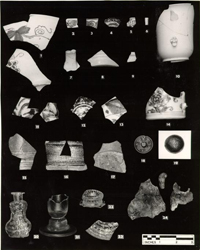 Figure 1. Well B. Ceramics, Glass and Small Finds.
Figure 1. Well B. Ceramics, Glass and Small Finds.
Figure 1. Well B.
- 1.
Rim and base fragments of delftware bowl with pale buff body and decorated in cobalt. The exterior decoration, somewhat poorly executed, depicts a grape vine. A crude St. George's cross composed of four dashes not touching in the center and an eye-like design appear in a band on the interior, approximately an inch below the rim. This design appears on a number of different objects of delftware found on the Wetherburn and Charlton lots during the 1965-1966 excavations. A few of these are shown in Volume III, Figure 6, Numbers 14-26. Previous Williamsburg excavations have produced a platter [3722-17.F] from the William Randolph Lodging, plates [3723-2.G.1 and 3724-2.B.1] from the Semple and Chiswell House sites on Francis Street and a tankard [3725-29.D] from the lot due north of the Brush-Everard House with the same pattern. A rim of a bowl found at the James Geddy site has the same internal and external designs and was found in a deposit made c.1765 [3792.ER:1322F-19B]
Date of deposit: post 1750 3350.ER:1139A-9N
- 2.
Rim fragment of delftware plate with buff body and a botyroid decoration in cobalt.
Date of deposition: post 1750 3351.ER:1139A-9N
- 3.
Rim fragment of delftware sweetmeat or trinket tray probably triangular in shape. The body is buff, the exterior undercoated, the interior with a hand-painted, cobalt design of scrolls surmounted by a single line. The rim is everted.
Date of deposit: post 1750 3352.ER: 1139A-9N
- 4.
Base of small cup of delftware with pale buff body and wedge-sectioned foot ring. There is a single cobalt line at the exterior junction of the foot and body, which is a zone of lattice-work, also hand painted in cobalt. The interior appears to be undecorated.
Date of deposit: post 1750 3353.ER: 1139A-9N
- 5.
Body fragment of small bowl or cup of delftware with pale buff body, no interior decoration but with a hand-painted, cobalt, exterior dotted design possibly Oriental in character.
Date of deposit: post 1750 3354.ER: 1139B-9N
- 6.
Portion of round-sectioned delftware handle from small can or cup with pale buff body. The exterior, or face, shows a number of horizontal cobalt dashes enclosed by vertical lines while the interior is undecorated.
Date of deposit: post 1750 3355.ER: 1139B-9N
- 7.
Upper handle fragment of tankard of white salt-glazed stoneware. The body is pure white, coarse in texture and slipped with a finer, whiter clay. The handle has a single central groove and shows the lower edge of a dab of iron oxide applied to its apex.
Date of deposit: post 1750 3356.ER: 1139A-9N
- 8.
Base fragment of tankard of white salt-glazed stoneware with buff body and surface and three cordons above foot.
Date of deposit: post 1750 3357.ER: 1139A-9N
- 9.
Rim fragment of bowl of white salt-glazed stoneware with rolled rim flattened on top. The body is drab and coarse white, covered with a thick glaze.
Date of deposit: post 1750 3358.ER: 1139B-9N
- 10.
Cup of white salt-glazed stoneware, very thin and finely potted. The rim is everted, the foot ring straight while the base of the ribbed handle was pinched off vertically and then horizontally.
Date of deposit: post 1750 3359.ER: 1139A-B-9N
- 11.
Two fragments of cobalt decorated grey stoneware, each from a small globular pitcher. The decoration in both cases is floral in character and has been incised and in part infilled with cobalt. The right-hand fragment shows traces of having come from beside an applied motif. Westerwald.
Date of manufacture: 1700-1730 Date of deposit: post 1750 Left-hand fragment 3360.ER: 1139A-9N Right-hand fragment 3794.ER: 1139A-9N - 12.
Base of small tea bowl, earthenware body completely covered with mottled manganese glaze (tortoiseshell). The small foot-ring is square cut.
Date of deposit: 1750 3361.ER: 1139A-9N
- 13.
Base of saucer of Chinese export porcelain decorated in the "Imari" style in underglaze red and blue, and overglaze red and gold.
Date of deposit: post 1750 3362.ER: 1139B-9N
- 14.
Lower portion of can of Chinese export porcelain decorated on exterior in underglaze blue with three lines immediately above the flat unglazed base, surmounted by a peony. The round-sectioned handle is attached above the group of lines while a stylized spray of leaves has been drawn on either side at the junction of handle and wall. Portion of a similar can was found at the James Geddy House in a deposit made post 1770 [3795.ER: 1348N-19B].
Date of deposit: post 1750 3363.ER: 1139B-9N
- 16.
Base fragment of brown salt-glazed stoneware tankard with grey-buff body, almost certainly a product of the Rogers' pottery at Yorktown, Virginia, (see Watkins and Noël Hume, p. 79A). The exterior is a dark grey mottled with buff. Above the base is a single cordon, a plain zone and then a pair of cordons. Virginian.
Date of manufacture: 1725-1745 Date of deposit: post 1750 3870.ER: 1139A-9N - 16.
Rim fragment of large jar of brown salt-glazed stoneware with grey-buff body containing mica particles. The tall neck is dished on its interior to take a lid. On the mottled brown exterior there is a cordon at top of the shoulder. English.
Date of deposit: post 1750 3869.ER: 1139A-9N
- 17.
Base of small pan of coarse earthenware with small red ocher particles in the orange-pink body suggesting a Yorktown, Virginia, origin (see Watkins and Noël Hume, p. 79A). The flat, unglazed base shows signs of considerable wear and has several patches of glaze adhering to it. A colorless lead glaze has been applied to the interior which has fired to a red-brown.
Date of deposit: post 1750 3366.ER: 1139A-9N
- 18.
Small cylindrical brass weight with central knob and two grooves around its perimeter. Two grooves around its top enclose the stamped letters as follows: at the bottom center, VR; to the left of the knob, OZ and below, 1; and to the right of the knob, D, and below 10; immediately above the knob, X, and an S. It is likely that the VR indicates an avoirdupois weight. "1 oz." and "D 10" show that it originally weighed one ounce and ten drams. Subsequent decay of the metal in the area of the "XS" has reduced this to one ounce nine and one quarter drams. Due to the prevalence of clipping coins prior to the development of the milled edge, it was common practice for tradesmen to weigh coinage and the "XS" refers to this weight being the equivalent of ten shillings in coins. A weight of the same original value (slightly less corroded) was found in a domestic trash deposit south of the existing smokehouse in association with artifacts of the period 1750-1765 and is shown in Volume II, Part III, Figure 1, No. 24.
Date of deposit: post 1750 3367.ER: 1139A-9N
- 19.
Domed brass stud, the central spike missing, from trunk or carriage. Origin uncertain.
Date of deposit: 1750 3368.ER: 1139B-9N
- 20.
For details of this bottle see Figure 3, No. 1.
3364.ER: 1139B-9N
- 21.
Lower portion of jelly glass (lead metal) with plain conical foot surmounted by a solid knop from which the cylindrical bowl emerges. Haynes plate 93g. English.
Date of deposit: post 1750 3871.ER: 1139B-9N
- 22.
Base of jelly or posset glass with plain foot and the bowl let into a milled collar. There is a kick in the base of the flaring bowl. For a glass with a similar base, see Thorpe Plate LXVI and Haynes Plate 60D. Another glass of this type was found in the orange-brick yard spread to the north of the kitchen with ceramics of the 1760's and with clay pipe stems which provided a deposition date of circa 1769 [3367.ER:1011E-9N]. English.
Date of deposit: post 1750 3872.ER:1139A-9N
- 23.
Fragment of lead glass, terraced, foot much burnt. Both sweetmeat glasses (Thorpe, Vol.2, plate LXVII) and candlesticks, (Thorpe, Vol. 2, Plate LIX) are known to have had this type of foot during the first decade of the eighteenth century. Fragments of similar feet from two other objects were found elsewhere on the site. English.
Date of deposit: post 1750 3873.ER:1139A-9N
- 24.
Three glass objects, or portions of glass objects, heavily burnt in a fire. To right is the upper portion of a clear glass phial; center is a trail of molten glass while to the left is a heavy mass of clear glass possibly originally a tumbler. English.
Date of deposit: post 1750 3369.ER:1139A & 1139B-9N
Figure 2. Well B.
Numbering upper left to lower right.
- 1.
Iron spade blade, upper portion missing.
Date of deposit: post 1750 3370.ER:1139B-9N
- 2.
Iron broad hoe, the socket tapering and extending into a flat triangular spine on the upper surface of the blade. No identifiable marks.
Date of manufacture: First half of eighteenth century. Date of deposit: post 1750 3372.ER:1139B-9N - 3.
Cylindrical object of sheet iron with flat bottom and rolled rim.
Date of deposit: post 1750 3374.ER:1139D-9N
- 4.
Section of iron cooking pot with elbow handle and only one of original three feet remaining. There are three body cordons, a pair close to the lower handle junction and a single one close to the foot junction.
Date of deposit: post 1750 3371.ER:1139B-9N
- 5.
Portion of iron tire with semi-circular section and with rectangular holes at intervals ranging from 2¼ ins. to 6½ ins.
Date of deposit: post 1750 3373.ER:1139B-9N
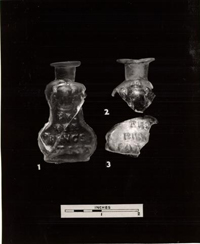 Figure 3. Well B. Turlington's Balsam Bottles.
Figure 3. Well B. Turlington's Balsam Bottles.
Figure 3. Well B.
- 1.
Small lead-glass mold-made, clear bottle bearing the legend (running onto all sides) that it was devised in "London March 26 1750 By the King's Patent Rob Turlington's Balsam of Life". The front also shows the arms of George II while the back has an unidentifiable coat of arms. The ogee curved sides of this bottle are in contrast to the sharply angled sides of the most common form of this bottle which bears the patent date of January 28, 1754. At the later date, when informing his customers of the new bottle, Turlington explained that people who had been "buying up my empty Bottles, have basely and worldly put therein a vile spurious Counterfeit-Sort". It is not unreasonable to suppose that the Wetherburn bottle is one of the type that he had hitherto used. The original Balsam of Life was a compound of many ingredients whose precise date of origin is unknown. However, in 1747 its inventor published a pamphlet of 46 pages extolling its virtues and relating testimonials from satisfied users on two continents. English.
Date of manufacture: 1750-1754 Date of deposit: post 1750 3364.ER:1139B-9N - 2.
Neck and upper body portion of bottle identical to Number 1 but slightly larger. English.
Date of manufacture: 1750-1754 Date of deposit: post 1750 3375.ER:1011F-9N - 3.
Lower front body portion of bottle similar to Number 1, but slightly larger. English.
Date of manufacture: 1750-1754 Date of deposit: post 1750 3376.ER:1016A-9N
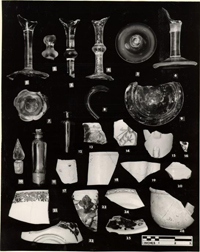 Figure 4. Well C. Glass and Ceramics.
Figure 4. Well C. Glass and Ceramics.
Figure 4. Well C.
- 1.Portion of lead-metaled wine glass with folded foot, straight stem and ogee bowl. English.
Date of manufacture: 1740-1760 Date of deposit: post 1765 3754.ER:1135R-9N - 2.Portion of wine glass stem (lead metal) with bladed knop surmounted by a fragmentary ball knop. A tear runs through both knops. A straight outcurving at the upper edge suggests that the bowl was joined to the stem directly above the ball knop. English.
Date of manufacture: 1740-1760 Date of deposit: post 1765 3755.ER:1135R-9N - 3.Wine glass stem (lead metal) with solid straight stem, central angular knop, and possibly an ogee bowl.
Date of manufacture: 1765-1780 Date of deposit: post 1765 3756.ER:1135F-9N - 4.4. Wine glass similar to No. 3 except that the metal is semi-opaque due to soil conditions and portions of the plain foot remain.
Date of manufacture: 1745-1770 Date of deposit: post 1775 3757.ER:1134P-9N - 5.5. Heavy, solid foot from firing glass or tavern dram with opaque twist stem with a core of four spiral tapes surrounded by a six-ply spiral band. English.
Date of manufacture: 1760-1775 Date of deposit: post 1765 3758.ER:1135S-9N - 6.Small wine glass (lead metal) with plain foot, straight stem and trumpet bowl. English.
Date of manufacture: 1780-1800 Date of deposit: post 1775 3759.ER:1134G-9N - 7.Petaled base of bowl or water glass with diamond molded body flaring sharply outwards. A water glass with a similar base and bowl is shown in Thorpe, Volume II, Plate CIX, Number 1. English.
Date of manufacture: 1735-1745 Date of deposit: post 1765 3760.ER:1135S-9N - 8.Glass handle, heavy lead metal probably from tankard or pitcher. English.
Date of manufacture: mid-eighteenth century Date of deposit: post 1765 3761.ER:1135S-9N - 9.
Lower portion of small clear, lead-glass tankard of cylindrical form. The base is thickened with an applied band and tooled into a sloping foot. There is a central pontil mark. English.
Date of deposit: post 1775 3762.ER:1134J-9N
- 10.Small solid "spire stopper" cut with slightly hollow diamond facets and ground where it penetrates the neck. This type of stopper could have been used with the one shot decanter in Figure 7, found fourteen feet lower down the well shaft.
Date of manufacture: 1750-1770 Date of deposit: post 1775 3403.ER:1134R-9N - 11.
Pharmaceutical phial, clear glass, small basal kick, flattened and everted rim over a short cylindrical neck and sloping shoulder. The neck retains its original cork surrounded by sealing wax. The bottle's contemporary contents have separated into a grey sediment and a yellowish liquid.
Date of deposit: post 1765 3763.ER:1135F-9N
- 12.
Small green glass phial with thick base and high conical kick, rim missing.
Date of deposit: post 1765 3764.ER:1135R-9N
- 13.
Rim sherd of plate of delftware, plain on the exterior and with chrome yellow frond-like decoration on the interior. The body is pale cream in color. Probably Dutch.
Date of deposit: post 1775 3466.ER:1134F-9N
- 14.
Base fragment of English delftware plate, plain on exterior, interior with hand-painted rendering of an Oriental figure puffing on a pipe. English.
Date of deposit: post 1775 3774.ER:1134R-9N
- 15.
Body section of small can of delftware undecorated with buff body, pinkish tinge to the glaze and small, crude, handle terminals. English.
Date of deposit: post 1765 3796.ER:1135R-9N
- 16.
Small fragment of delftware plate, decorated in blue, red and green in floral design on exterior, plain interior.
Date of deposit: post 1765 3797.ER:1135R-9N
- 17.
Fragment of can or small mug of white salt-glazed stoneware, the body buff and covered with a white slip. There is a single groove below the rim on the exterior while on the interior the body has been pared down to form a thin lip. A further fragment of this vessel was found at a lower level, 3765a.ER:1134Y-9N. English.
Date of deposit: post 1775 3765.ER:1134L-9N
- 18.
Oval relish or salad dish of white salt glaze stoneware with straight sides, flat base and a double groove close to the exterior rim. Since photography more fragments have been mended providing further dimensions. Width approximately 4¾ inches. Length approximately 6½ inches. Height 2 1/8 inches. English.
Date of deposit: post 1775 3766.ER:1134-9N
- 19.
Fragments of a white, salt glazed stoneware molded object with vertical fluting, possibly the upper section of a wall pocket. The interior is plain but the exterior has a molded decoration of trailing vines and flowers. Three fragments found with the illustrated piece were not of sufficient significance to merit inclusion in the photograph. English.
Date of deposit: post 1775 3767.ER:1134V-9N
- 20.
Fragment of a white salt glaze stoneware tankard, the base recessed within a square cut ring. The foot slopes into a cordon above which the body rises more vertically. Similar bases appear on a number of "scratch blue" tankards of the period 1752-1758, Plate 55 (dated 1752); Henry Francis DuPont Winterthur Museum Collection. Number J 8.920, dated 1758. The latter also having a trio of cordons above the single one as on another fragment from the same level. English.
Date of deposit: post 1775 3768.ER:1134J-9N
- 21.
Rim of bowl of Chinese export porcelain, hand-decorated under the glaze in blue with a band of flowers and leaves on the interior and with an overall design of thorny vines, flowers, and leaves on the exterior. The rim has been painted with iron oxide. Diameter approximately 10 inches.
Date of deposit: post 1775 3769.ER:1134G, 1134P-9N
- 22.
Base of bowl of Chinese export porcelain hand-painted in blue under the glaze with the foot missing. The interior decoration consists of a floral spray encircled by a double ring. On the exterior is a single band at the junction of body and foot, while the main body decoration probably consisting of an Oriental landscape.
Date of deposit: post 1765 3770.ER:1135S-9N
- 23.
Rim and body fragment of bowl of Chinese export porcelain with brown painted rim. Close to the rim on the interior an overglaze red band of diaper pattern broken by some decoration of unknown character in underglaze blue, the whole enclosed below by double underglaze blue lines and above by a single such line. The exterior decoration depicts an underglaze blue landscape and houses with detail added in overglaze red and gold. A large bowl similarly decorated was found to the west of the tavern and is shown in Volume II, Part II, Figure 25, Number 6. [3437.ER:1047A-9N]
Date of deposit: post 1765 3436.ER:1135H-9N
- 24.
Rim of small fruit plate of Chinese export porcelain, plain exterior, iron oxide on the edge and band of underglaze blue diaper design close to the rim. The surfaces of this vessel show the same gray mottling present on similar objects found on other Williamsburg sites. A section through a plate of this type with similar decoration and glaze was found in the James Geddy well whose primary deposit was made at approximately the same time as the primary filling of this well. [3798.ER:1340R-19A-B]
Date of deposit: post 1765 3771.ER:1135E-9N
- 25.
Fragment of base of plate of Chinese export porcelain, plain back and interior, hand painted, unglazed blue floral design enclosed by a double circle. The base is recessed with an unglazed edge.
Date of deposit: post 1765 3772.ER:1135N-9N
- 26.
Small pot of buff-colored earthenware coated with a lead (?) glaze which has fired to a greenish white where it is thick and a cream-gray in the thinner areas. The rim is folded above a wide groove, the latter presumably to facilitate sealing the pot with a cover secured by string or thread. The body incurves to a small, wedge-sectioned foot within which the base is recessed.
A similar vessel was found at the Travis House site in a deposit made between 1782-1790, The Travis House (Lot K) Site. Volume II. Report on the Artifacts Excavated during 1962-1963. Figure 8, Number 1. 2875.ER:532A, 532C-14G.
Provenance unknown as is date of manufacture.
Date of deposit: post 1775 3773.ER:1134P, 1134R-9N
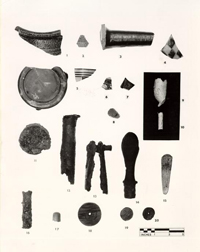 Figure 5. Well C. Ceramics and Small Finds.
Figure 5. Well C. Ceramics and Small Finds.
Figure 5. Well C.
- 1.
Thick rim of heavy jar of brown salt-glazed stoneware, the interior recessed and flanged to take a lid. The upper surface of the rim is slightly flattened, the exterior everted above sloping shoulders with a pair of cordons. English.
Date of deposit: post 1765 3775.ER:1135R-9N
- 2.
Small body fragment of salt-glazed stoneware with buff body, white slipped on the interior and with an iron oxide slip on the exterior. The latter has a number of bands of zig-zag rouletting. English, probably made in the Burslem district of Staffordshire.
Date of deposit: post 1765 3776.ER:1135P-9N
- 3.
Portion of handle of brownstone pipkin, the body orange-rust in color, the exterior covered with a thick lustrous glaze and between the glaze and the body a thin white line suggesting a product of the Nottingham kilns. The handle is hollow and the terminal missing.
Date of deposition: post 1765 3467.ER:1135R-9N
- 4.
Body fragment of pitcher of cobalt decorated grey stoneware decorated with an incised diamond pattern, alternate rows being filled with cobalt. Westerwald.
Date of manufacture: First half of eighteenth century
Date of deposit: post 1775 3468.ER:1134L-9N
- 5.
Base and rim fragment from a pitcher of lead-glazed, coarse agate ware. The base (from the upper levels of the well and an eighteenth century level under the near-by smokehouse) is externally unglazed and stands on a shallow, broad, foot ring. The glazed body is waisted above the foot and then flares outward.
The rim sherd, much thinner and more highly fired than the base fragment was found in a lower level of the well filling in association with the molded green-glazed plate, (Figure 6). The sgraffito decoration includes three narrow bands close to the rim and a checkerboard design of the same character as the pitcher, Volume II, Part II, Figure 33, Number 18. Dated examples of similarly decorated pieces include bowls dated 1750 and 1755, in the Victoria and Albert Museum.
Date of deposit (base fragment): post 1775 Date of deposit (rim fragment): post 1765 Base fragment - 3464.ER:1134P, 1165Z-9N Rim fragment - 3646.ER:1135R-9N - 6.
Rim fragment of cream-colored earthenware teapot with recessed rim to take a flush lid. There is a wide cordon below the rim below which a small portion of the molded decoration is present. This consists of the edge of a leaf and a stalk the background area being covered with the dot within a circle motif found on many objects of this type. The collar has been daubed with manganese before glazing and copper oxide has been applied to the area of the leaf, etc.. This fragment comes from a similarly decorated though larger and differently colored teapot to that found in the well at the James Geddy House [3777.ER:1340M, Q, R, V, - 19A-B]. The latter is colored entirely in gray and brown, has the main portion of the body covered with the dot and circle device, shows the veined handle usually ascribed to the Wedgwood factory, and has a base recessed within a plain foot. It was apparently deposited circa 1765, a date which coincides remarkably closely to the date of the abandonment and filling of the Wetherburn well. The latter yielded a fruit pattern plate with the same motif covered with the green glaze perfected by Josiah Wedgwood in 1759-1760. [Figure 6, 3385.ER:1135R, S, T-9N] Fragments of other green-glazed plates were found elsewhere on the site [Figure 19, Numbers 19, 20, and 21. 3381.ER:1017 etc. -9N, 3386.ER:1040C-9N]
Date of manufacture. 1755-1770 Date of deposit: post 1765 3377.ER:1135F-9N - 7.
Body fragment of molded pickle leaf with creamware body, green-glazed on both sides, the green of the type perfected by Josiah Wedgwood about 1759-1760.
Date of manufacture: 1760-1770 Date of deposit: post 1765 3378.ER:1135E-9N - 8.
Small fragment of red flock material possibly from upholstery. The Department of Collections suggested an English origin for this.
Date of deposit: post 1765 3783.ER:1135R-9N
- 9.
Portion of bowl of clay tobacco pipe with molded decoration of the Hanoverian Royal Arms. The right supporter is missing as is the end of the motto. A large number of similarly decorated pipes were found elsewhere on the site, (see Volume II, Part III).
Date of deposit: post 1765 3781.SR:1135R-9N
- 10.
Stem fragment of clay tobacco pipe with molded scale-like decoration, two cordons and a band of fleur-de-lis. Probably Dutch.
Date of deposit: post 1765 3781.ER:1135A-9N
- 11.
Small circular iron lid perhaps from cannister; in extremely poor condition.
Date of deposit: post 1765 3473.ER:1135R-9N
- 12.
Cylindrical iron object with flange at one end and incomplete at the other. In extremely poor condition but probably part of a candle-mold.
Date of deposit: post 1765 3474.ER:1135R-9N
- 13.
Iron sleeve from spade with iron bolt for fixing wooden handle.
Date of deposit: post 1765 3812.ER:1135R-9N
- 14.
Pear-shaped wooden handle for iron tool which fitted over the cylindrical top and abutted against a collar.
Date of deposit: post 1765 3477.ER:1135R-9N
- 15.
Two-piece bone cutlery handle, tapering to the shank and with rounded end, formerly covered by an iron plate held by four small iron nails. There are traces of the original iron tang into which the plates fitted. The handle is decorated on both sides with incised lines radiating from the shank end.
Date of deposit: post 1765 3475.ER:1135R-9N
- 16.
Badly corroded brass ferrule still containing original wood, the latter held in place by a brass nail. Probably from cane, riding crop, or umbrella.
Date of deposit: post 1765 3476.ER:1135R-9N
- 17.
Small brass thimble with convex top, small circular recesses on the body and a plain band above the rim.
Date of deposit: post 1765 3469.ER:1135R-9N
- 18.
Disc of close-grained wood with square hole in center, possibly a washer.
Date of deposit: post 1765. 3470.ER:1135R-9N
- 19.
Small wooden disc, possibly a button blank.
Date of deposit: post 1765 3471.ER:1135R-9N
- 20.
Wooden button with circular central hole and bevelled upper face.
Date of deposit: post 1765 3472.ER:1135R-9N
 Figure 6. Well C. Chinese porcelain bowls and green-glazed plate.
Figure 6. Well C. Chinese porcelain bowls and green-glazed plate.
Figure 6. Well C.
Left:
Punch bowl of Chinese export porcelain, the foot ring unglazed on its lower edge, the rim coated with iron oxide. All the decoration is hand painted in blue under the glaze. There is a zone of diaper pattern alternating with floral cartouches close to the internal rims and a peony in the bowl's center. The exterior has floral sprays and one large design of rocks, peonies, and willow trees. Height 3¾ inches, rim diameter 9 1/8 inches, base diameter 4¼ inches.
| Date of manufacture: | 1740-1760 |
| Date of deposit: | post 1765 |
| 3779.ER:1135R, 1135S, 1135T-9N |
Right:
Bowl of Chinese export porcelain, with tall foot ring unglazed on its lower edge. The bowl is decorated inside and outside under the glaze in blue. There is a floral spray in the center of the bowl and a band of diaper decoration close to the iron oxide-coated rim. The exterior has floral springs and a larger design of rock, peonies, and willow trees. Unmarked. Height 3½ inches, rim diameter 7½ inches, base diameter 3¾ inches.
| Date of manufacture: | 1740-1780 |
| Date of deposit: | post 1775 |
| 3778.ER:1134P,1134R-9N |
Center:
Round molded plate with cream-colored earthenware body covered on both faces with the brilliant green glaze perfected by Josiah Wedgwood in 1759-1760, and made by him and other English potters till about 1774.
The outer section of the rim consists of stylized "vines" intertwining in a series of figures of eight with plain oval areas in the centers. From each of the twelve crossing points of the "vines" hang a series of three different clusters of fruit and leaves, the lower leaf in each case flowing down the bowl. The area between the clusters on the rim is covered with an incised dot and circle motif, the wall is plain except for the aforementioned leaves, but the dot and circle motif covers the bottom of the plate completely.
The quality of the molding on this plate is far superior to the molding of another plate represented by fragments (Volume II, Part II, Figure 19, Number 21, 3386.ER:1040C, 1040L, 1017B-9N) found in the yard to the east of the kitchen. However, fragments of two or more other plates of this design and similar quality came from the areas surrounding the kitchen on the north and west [3385.ER:1030D, 1030E, 1047A, 1124, 1124E, and 3383.ER: 1108-9N]
| Date of manufacture: | 1760-1770 |
| Date of deposit: | post 1765 |
| 3385.ER: 1135R, 1135S, 1135T-9N |
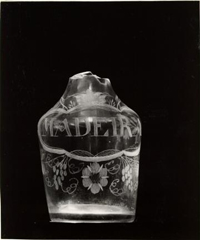 Figure 7. Well C. Label Decanter.
Figure 7. Well C. Label Decanter.
Figure 7.
- 1.
Clear lead glass decanter with broad shoulders and sides tapering to the base. The small size of this vessel (base diameter 2¼ ins., height to shoulder 2¾ ins.) indicates that it was a "one shot" decanter, an unusually small size to find in use in a tavern. The body is engraved with a chain on which "hangs" a label bearing the legend "MADEIRA" and surrounded by appropriate decoration such as grapes, grape leaves, and tendrils. From each extreme edge of the label a spray of flowers, possibly grape flowers, winds across the shoulders. Immediately below the center of the label is a "Tudor rose" motif. The neck is missing. An advertisement in the Norwich Mercury for 26 December 1755 describes "New fashioned decanters with inscriptions engraven on them, Port Claret Mountain, etc., etc., decorated with vine-leaves, grapes, etc." Such decanters remained popular until about 1770. In 1764 the New York Weekly Post was advertising "new fashioned decanters labelled Madeira". (Thorpe, Volume I, page 319 and Volume II plate CXXVII.) The closest parallel for the shape and for the design of engraving is illustrated in the Antique Dealer & Collectors' Guide. Volume 15, Number 11, New Series, June 1961, page 35, although the Wetherburn example has broader shoulders. The common form of stopper for a decanter of this type would appear to be the "spire stopper", but with slightly hollow diamond facets. A stopper of this type and of a suitable size was found at a depth of 5½ feet. [3404. ER: 1134R-9N, Figure 4, Number 10].
Date of manufacture: 1755-1770 Date of deposit: post 1765 3403.ER:1135F-9N
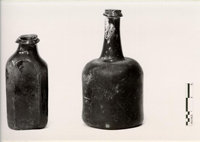 Figure 8. Well C. Beverage Bottle and Snuff Bottle.
Figure 8. Well C. Beverage Bottle and Snuff Bottle.
Figure 8. Well C.
Left:
Snuff or blacking bottle of olive-amber metal, octagonally molded and with uneven base. The neck has been struck off at an angle and the flattened string rim has been applied at the top of the neck on one side.
| Date of manufacture: | 1750-1770 | |
| Date of deposit: | post 1765 | 3408.ER: 1135S-9N |
Right:
Wine bottle of dark green metal (slightly amber when seen by transmitted light) with cylindrical body, high basal neck, long neck slightly sinking into the body, and flattened and down-tooled string rim.
| Date of manufacture: | 1745-1760 | |
| Date of deposit: | post 1765 | 3407.ER:1135T-9N |
Figure 9. Well C.
Left to Right:
Child's leather shoe with square tongue, possibly fastened by passing a thong through a slit on each "wing" of the heel. The latter has a semi-circular leather liner to prevent abrasion of the foot by the rear seam. The heel sole is pegged to the main sole and shows considerable evidence of wear. Length of sole 5 inches.
| Date of manufacture: | 1760-1765 | |
| Date of deposit: | post 1765 | 3783.ER:1135R-9N |
Young adult's right shoe with both the inner liner and outer sole worn through, the heel showing considerable wear and the upper roughly cut off except for the small strip which is sewn to the heel pieces. This upper was presumably salvaged to mend other shoes. The heel is pegged to the sole, there are no thong holes but a number of small prong holes on one strap suggests the use of a small buckle. Heel pegged to the sole. Length of sole 6¾ inches.
| Date of manufacture: | 1760-1765 | |
| Date of deposit: | post 1765 | 3786.ER:1135Q-9N |
Adult shoe, the soles missing with rounded toe, the left hand flap showing considerable evidence of wear by the tines of a buckle. Some small holes on the opposing flap may be sewing holes for a buckle.
Length of sole 7½ ins.
| Date of manufacture: | 1760-1765 | |
| Date of deposition: | post 1765 | 3785.ER:113 5S-9N |
Adult shoe, the sole completely worn away from the toe area, the heel missing. A semi-circular leather patch had been sewn to the side of the shoe.
Length of sole. 9 ins.
| Date of manufacture: | 1760-1765 | |
| Date of deposition: | post 1765 | 3786.ER:1135Q-9N |
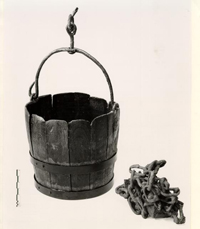 Figure 10. Well C. Well Bucket and Chain.
Figure 10. Well C. Well Bucket and Chain.
Figure 10. Well C.
Oak well bucket formed of thirteen staves of uneven width, and possessing a two piece bottom. The whole was hold together by two iron loops (those shown in the photograph are modern copies) one at the base and the other having its lower edge some 3¼ inches higher. A pair of iron eyes were fastened to the outside of opposing staves by two and three nails. The single piece iron handle had an iron link permanently attached to it by a swivel eye. A mass of chain of the same size links (plus sections with smaller links) was found also in the fill close to the bucket. Although it was not possible to unravel the corroded chain, it is known to have been at least five feet long with another swivel in its mid section. Both swivels were intended to enable the bucket to spin on its way up without tangling the chain. The rig had presumably seen a great deal of use, for some of the chain links had almost worn through and had been reinforced with thongs. There can be little doubt that bucket and chain were raised and lowered by means of a windlass and not by direct hauling over a block. Height 1' 1¾". Internal base diameter 1'¼". Rim diameter 1' 2". Capacity approximately 6 gallons.
Date of deposition: post 1765 3780.ER:1135R-9N
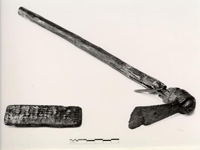 Figure 11. Well C. Adze and Brush.
Figure 11. Well C. Adze and Brush.
Figure 11. Well B.
Lower portion of rectangular wooden brush back with remains of bristles arranged in eight rows of sixteen tuffs. The upper portion of the brush back was nailed to the existing fragment by four inch long nails, two of which survive. This may have been an ostler's brush.
Date of deposit: post 1765 3405.ER:1135R-9N
Iron adze1 with lower portion of the original oak handle still attached. The handle was broken prior to the discarding of the tool and a temporary repair was attempted by driving another piece of wood into the eye. The cutting edge is slightly saucered and the eye is wedge shaped. Length of handle 2 feet 2 inches - Length of blade 9½ inches.
Date of deposit: post 1765 3406.ER:1135P-9N
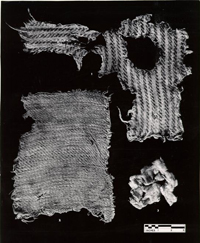 Figure 12. Well C. Fabrics and Stuffing.
Figure 12. Well C. Fabrics and Stuffing.
Figure 12.
- 1.
Two pieces of wool, twill-woven with beige and dark brown threads. A blanket of a similar fabric is in the Department of Collections, Catalogue number 1946-110 (3988) Probably American. This attribution was provided by the Department of Collections.
Date of deposit: post 1765 3438.ER:1135R-9N
- 2.
Fragment of wool, twill-woven in beige. Probably American. This attribution was provided by the Department of Collections.
Date of deposition: post 1765 3439.ER:1135R-9N
- 3.
Fragment of unspun wool probably furniture stuffing. Origin unknown.
Date of deposit: post 1765 3799.ER:1135R-9N
Photograph Negative Numbers
| Figure 1 | 67-SMT-241 |
| Figure 2 | 67-SMT-144 |
| Figure 3 | 67-SMT-209 |
| Figure 4 | 67-SMT-131 |
| Figure 5 | 67-SMT-217 |
| Figure 6 | 67-SMT-213 |
| Figure 7 | 67-SMT-152 |
| Figure 8 | 67-SMT-123 |
| Figure 9 | 67-SMT-109 |
| Figure 10 | 67-SMT-121 |
| Figure 11 | 67-SMT-117 |
| Figure 12 | 67-SMT-227 |
